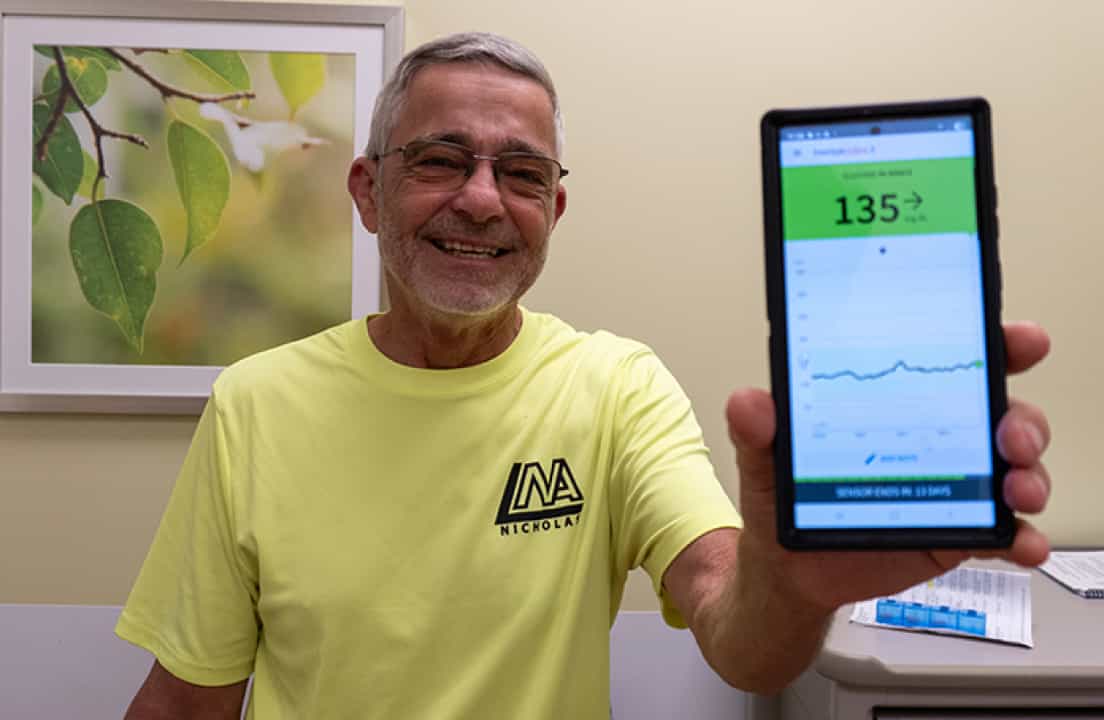T1D Guide
T1D Strong News
Personal Stories
Resources
T1D Misdiagnosis
T1D Early Detection
Research/Clinical Trials
Finding the Right Automated Insulin Delivery System for You
The combination automatically adjusts insulin delivery to help control blood glucose levels and keep the ideal time in range (TIR). TIR is the happy medium those with diabetes spend with their blood sugar levels in a recommended target range. Your physician helps determine this challenging feat, and finding the right automated insulin delivery system will almost guarantee it.

If you’ve ever wondered what exactly an automated insulin delivery system (AID) is, and if it’s right for you, read on! AID or as it’s sometimes called, the artificial pancreas, is groundbreaking technology for individuals with diabetes that includes an insulin pump/pod and a continuous glucose monitoring system working in tandem.
“Studies with various AID systems unequivocally demonstrate improvement in glycemic outcomes in people with T1D across all age groups, in all genders,” cites the Endocrine Reviews 2023.
As individuals with diabetes battle keeping their blood sugar in check, they also combat hypoglycemia (low blood sugar) and hyperglycemia (high blood sugar). In addition, AID systems lessen the burden of daily diabetes management and reduce diabetes burnout while improving hemoglobin A1C (HbA1C) results.
What Exactly is an AID System
An automated insulin system combines continuous glucose monitoring (CGM) and an insulin pump or pod. AIDs are hybrid closed-loop systems allowing ongoing communication between the CGM and insulin pump. It’s named an artificial pancreas or bionic pump because the technology replaces the function of the pancreas.
In the auto-immune disorder type 1 diabetes, the immune system attacks the pancreas’ insulin-producing beta cells. Insulin assists the glucose in your bloodstream to enter the body’s cells to use for energy. Without it—the body’s cells starve, and the sugar gets trapped in the bloodstream. In severe cases, T1Ds and T2Ds may experience a life-threatening complication called diabetic ketoacidosis (DKA) that may lead to diabetic coma or death if left untreated; another additional advantage of automated delivery systems! They are not only improving the quality of lives but saving them as well.

How the AID System Works
The hybrid closed-loop technology creates a ring of transmission between your diabetes devices, generally every five minutes. The CGM reads your blood sugar and reports the glucose level to the insulin pump or pod, recording constant fluctuations.
The pump/pod then adjusts the insulin delivery using algorithms to control the output. These algorithms are the brains behind the AID system. They figure out which direction your blood is headed and adjust accordingly.
Pro Tip: Another benefit of AIDs is that most have unique features that protect against low blood sugar during exercise to reduce insulin delivery.
How Do Insulin Pumps Work
If you’ve wondered how insulin pumps work, these smart devices deliver insulin through a tiny catheter inserted into the skin. This site must be changed every three to four days. There is also insulin therapy now with a surgically implanted insulin pump that lasts up to 1.7 years.
An insulin pump gives rapid or short-acting insulin in two ways:
Basal: A small dose of insulin that continuously infuses insulin throughout the day and night.
Bolus: The Insulin you take for meals or high blood sugar to correct rising blood glucose levels.
A standard insulin pump has fixed delivery rates you determine with your doctor. Without linking to a CGM, this is a more hands-on approach to insulin therapy.
When linked with the CGM, it’s considered a hands-off method for diabetes management. The continuous glucose monitor contains a tiny disposable sensor inserted under your skin. Another new type of CGM sensor may be implanted inside your body by a physician.
The Catch with some AID systems is that individual users still need to bolus for food intake (carbohydrate counting) and exercise.

The Different Types of Automated Insulin Delivery Systems
With all the choices on the market, choosing the right insulin delivery system is important. Technology keeps moving forward, with new enhanced options being introduced every day. Understanding these systems and the different terminology can help you decide what is right for you.
First, know that insulin pumps can be—open loop, closed loop or hybrid.
Open Loop System
Open-loop systems are when a person uses a CGM and pump, but this design needs user input. It’s not automatically entered. All manually controlled insulin delivery methods are considered open-loop—insulin pens or traditional insulin pumps/pods. All AID systems can be in open-loop mode to manually control insulin delivery.
Hybrid Closed Loop AID System
Hybrid closed-loop systems can be hands-off (automated). The CGM and pump/pod’s communication triggers automatic adjustments to keep glucose in the target range. With this method, the user still needs to bolus for meals and adjust for exercise, hence the hybrid system.
Here are a few FDA-approved hybrid closed-loop systems:
Tandem t:slim x2™ insulin pump with Control-IQ and Dexcom G6 or G7 CGM (age six and older)
Medtronic MiniMed™780G insulin pump (age seven and older)
Medtronic MiniMed™770G insulin pump (age two and older) and Guardian™Sensor CGM (age two and older)
Tandem Mobi: Approved by the FDA in July 2023, this is the smallest AID system, fully controlled with an iPhone.
Omnipod®5 insulin pod and Dexcom G6 or G7 CGM, the first tubeless AID system. (age two and up). This technology predicts trends 60 minutes out and adjusts insulin automatically designed to deliver glucose range to users.
Closed Loop AID Systems
The future lies in the closed-looping system that does not require input for insulin dosing. The first FDA-approved closed-loop system available for ages six and up is the iLet Bionic Pancreas from Beta Bionics.
This incredible hands-off system is virtually decision-making-free, an incredibly revolutionary management system for T1Ds. With this BIONIC system, the user only needs to enter their weight and tell the pump when they’re eating small, medium, or large meals—with no more carb counting or math for insulin dosing.

Changing the Future for T1Ds
The key takeaway is that AID systems provide overall benefits for T1Ds in achieving their target range. They also protect against low and high blood sugar levels while sleeping and reduce the burden of micromanaging glucose levels—freeing you from manually inputting and guarding your numbers around the clock.
Stay in the know and watch future trends – diabetes technology is constantly changing and transforming lives.


.webp)





.webp)
.jpg)
.jpeg)
.jpg)




.jpg)



.jpg)




.jpg)

.jpg)



.jpg)

.jpg)




.jpg)
.jpg)
.jpg)
.jpg)
.jpg)
.jpg)
.jpg)

.jpg)
.jpg)

.jpg)



.jpg)
.jpg)
.jpg)

.jpg)

.jpg)














.jpg)


.jpg)







.webp)











.webp)























.webp)